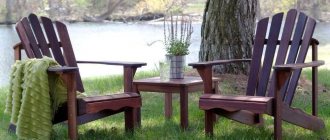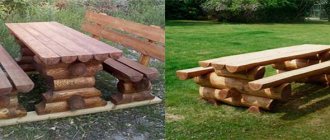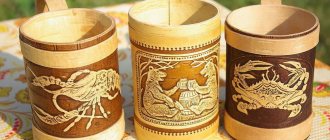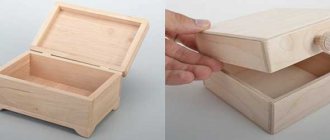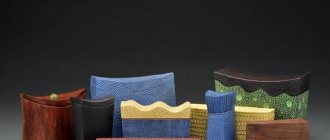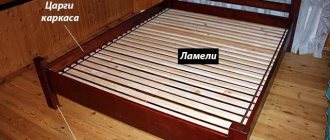Manufacturing of rivets
Making oak tubs involves careful preparation of the wood. The workpieces must be split, since sawn material is unsuitable.
First you need to pick up an old, damp tree and cut down its lower part. Decide on the height of the tub in advance, since you will need to saw off the block a couple of centimeters more. The stock is needed for processing cuts.
We split the lump in half using a hatchet in a radial direction. And we do this with all the parts. The number of rivets is determined by the size of the future tub. To increase the number of rivets, you can cut lumps from a quarter or chop off an acute corner from its sides. In this case, it can be divided into another 2-4 parts. The thickness of a good rivet should not be less than 2-2.5 cm.
After the material has been sorted, it needs to be trimmed. To do this we use a hatchet. The ideal ratio of the diameter of the bottom and the height of the tub should be 35 to 49. This way it will be visually pleasing to the eye. If you want to make it taller, make the diameter larger, and vice versa. To determine the volume of a container, you need to use the formula for the volume of a cylinder.
The required number of rivets can be calculated using the formula:
, where D is the indicator of the lower diameter of the tub; π—constant 3.14; W is an indicator of the width of the workpiece at the bottom of the tub.
To determine the diameter of the bottom, you need to focus on the chimes. The rivets going to the bottom should be wider.
Related materials:
- Soaring feet in an oak tub
- Advantages of salting in tubs
Making a hoop
Another detail is the hoop. It helps to connect all the rivets, creating a single whole; stainless steel is used to make the hoop.
Modern barrels have three hoops:
- Farts (closer to the center)
- Morning (closer to the edge)
- Neck (if the barrel has a large volume, additionally placed between the first two)
The size of the hoop depends on the volume of the container (thickness*width):
- Up to 25 l – 1.6mm*3cm
- 25 – 50 l – 1.6mm*3.6cm
- Up to 100 l – 1.6mm*4-4.5cm
- 120 l or more – 1.8*5cm
Stainless steel hoops for barrels
You will need temporary metal hoops, which are made according to the following algorithm:
- Cut the required size strips from a sheet of steel
- Make holes at the ends of the strips and fasten them with rivets.
Preparation of rivets
To bring the workpieces into proper shape, they must be planed with a plane to equalize their thickness. The inner side is planed using sherhebel, and then divided in half lengthwise with a pencil. This is necessary for trimming the workpiece using a hacksaw with fine teeth.
Using a jointer, both the outside and sides of the workpieces are finished. The correctness of actions is checked using a pre-prepared pattern. It is made focusing on the lower hoop of the product. Ideally, the template will fit snugly to the sides and front. Please note that one hundred strict sides cannot deviate from the lines that divide the workpiece in half.
To achieve a cone-shaped product, it is necessary to strictly observe the proportions: the width of the riveting at the bottom should be greater than at the top.
What tools are needed to assemble barrels?
Having decided to make your first barrel, keg or tub, you need to equip your workplace and stock up on the necessary tools, fixtures, and available materials. In addition to the usual carpentry kit, you will need to stock up on special cooperage equipment, fixtures and tools. This:
- carpentry workbench equipped for cooperage;
- cooper's long jointer, circular humpback plane;
- a device for planing the edges of the boards from which the product is assembled);
- devices for tightening rivets (frame machine-gate, chain tie, post gate);
- plow, stapler, stapler;
- hand-made patterns and templates;
- metal or wooden clamps for assembling the barrel frame;
- morning maker (a device for cutting a morning groove into which the bottom of the product is inserted);
- heels (metal, wood, combined), tension for hoop;
- cooper's bracket.
Fixtures and measuring instruments
It should be taken into account that coopers make a significant part of the devices and tools themselves, “to suit themselves”, ensuring that the handles of the tools are held in the palm like a glove, and that the machines and workbenches are of the same height.
On the left is a two-handed, on the right is a one-handed morning drill and how to work with it
Assembling the tub
Making tubs with your own hands does not involve making all the hoops at once. First you need to make the middle ring. After it has been made from a strip of hot-rolled steel, 3-5 cm wide, the hoop is placed vertically on a clean wooden base. About 6 rivets are placed inside it, one of which (far left) is clamped with a clamp. After this, we install the remaining blanks and carefully lift the structure. They will only fit snugly with careful fitting and care.
Next, we make the remaining hoops and stuff them onto the product. The final touches are internal processing. Using a plane with a false blade and a chisel, you need to make a chamfer inside the lower end, removing 1/3 of the thickness of the workpiece. Next, process the end part of the frame and half-fill the upper end.
You might be interested in our tubs
- for test
- oak
- fake
Cooperation craft - how to become a master
If you are in a decisive mood, have skills in woodworking, and your hands are always growing, why not try to realize the idea of becoming a home cooper (cooper)? Cooperation is a difficult craft that comes from ancient times. Nowadays there are very few masters of this craft, and there are only a few highly qualified craftsmen. Therefore, cooperage products are rare on the market, and even if you can find them, either the price or quality does not please the buyer.
Barrel assembly process
We put the bottom
To install the bottom, you need to make a groove at a distance of 5 cm from the bottom. A chamfer is removed from both sides of the groove, and then the required circle is drawn on the bottom shield. It is created using special metal pins or nails. For them you need to make preliminary holes in the workpieces.
A bow saw is used to cut out the bottom. The bottom is placed on a workbench and planed clean on both sides at the end. Next, draw a line in the middle, the thickness of which is about 0.3 cm. Draw circles on both sides, the radius of which will be about 2.5-3 cm. You need to chamfer along these boundaries.
After this, we put the bottom in a tub. To do this you need to knock down the hoop a little. Next, insert the base into the groove and return the hoop to its place. The main thing is to make sure that there are no gaps between the bottom and the gaps. You also need to make several jambs on which the load will then be installed.
A little time and effort, and your tub is ready!
We are informing you:
Skillful hands
How to make a wooden barrel or tub?
Dnny
| 27 478 | 18-02-2014, 09:13 |
Barrels and tubs are in great demand in households. They keep lard and hams in brine, ferment cabbage, and soak apples. What can be compared to, for example, a cucumber or a tomato pickled in an oak tub? And in a linden barrel, honey and apple juice are perfectly stored, and you can make kvass in it.
Finally, an oak tub with a lemon or laurel tree today will not spoil the interior of even a city apartment. You just can’t find these simple products either in the store or on the market. But you can do it yourself, and although this task is not an easy one, an amateur craftsman is quite capable of handling it. Let us tell you in more detail about the manufacture of these containers needed in the household.
First of all, you need to choose wood. Oak and pine are unsuitable for storing honey - honey darkens in an oak barrel, but in a pine barrel it smells like resin. Here you need linden, aspen, and plane tree. Poplar, willow, and alder will also do. But for pickling, pickling or soaking, there is nothing better than oak - such a barrel will last for decades. For other needs, you can use sedge, beech, spruce, fir, pine, cedar, larch and even birch.
The following table will help you determine the size.
| External dimensions | Width and depth of the morning groove | Distance from the morning groove to the end | |||
| Barrel capacity (l) | Height | Bunch diameter | In my head | ||
| 15 | 345 | 295 | 262 | 3*3 | 20 |
| 25 | 420 | 340 | 300 | 3*3 | 20 |
| 50 | 535 | 420 | 370 | 3*3 | 25 |
| 100 | 670 | 515 | 450 | 3*3 | 25 |
| 120 | 770 | 525 | 460 | 3*3 | 25 |
Please note that the dimensions of the barrels are given here to select the size for the tub, the height and diameter of the head remains the same. The diameter in the barrel bunch (diameter in the center) for the tub goes into the diameter of the bottom.
When the size is chosen, you need to start preparing the stave, the main component of the barrel.
I will give the sizes of the rivets
| Capacity | Rivet width | Rivet thickness | Thickness of the bottoms | Bottom width |
| 15 | 40-90 | 14 | 16 | 50 or more |
| 25 | 40-90 | 14 | 16 | 50 or more |
| 50 | 40-90 | 17 | 19 | 50 or more |
| 100 | 40-100 | 18 | 19 | 50 or more |
| 120 | 40-100 | 18 | 19 | 50 or more |
There is another way to determine the size. The ratio of the diameter of the height of the tub or barrel should be in proportion, for example, 350:490 mm (Fig. 1-6). By increasing or decreasing the height, the diameter of the container is changed. The number of rivets for a barrel or tub is calculated using the formula 2*Pi*R/W, where R is the radius of the tub in the lower section (for a barrel - in the middle); “Pi” is a constant value equal to 3.14; W - the width of the stave at the bottom of the tub (for a barrel - in the middle).
Rivets
Usually the lower part of the trunk of old trees is used for rivets; it is called “riveter”. But a tinkerer will choose blanks from ordinary firewood and adapt a thin trunk to the job. It is best to make rivets from raw wood. First, the log - it should be 5-6 cm longer than the future stave - is split in half, gently tapping the log on the butt of the ax. Each half is then again split into two parts and so on, depending on the thickness of the chock, in order to ultimately obtain blanks 5-10 cm wide (for sweet clover - 15 cm) and 2.5-3 cm thick. You just need to try to split went radially - this will protect the riveting from cracking in the future.
The chopped pieces are dried in a room with natural ventilation for at least a month. To speed up the process, you can use a dryer. The dried workpiece is processed with a plow or sherhebel and a plane.
Rivet marking.
Take a board with a width of 30 to 100 mm, draw a line along the outer side dividing the stave in half along the width (for a barrel, and along the length). For the taper of the tub (barrel), it is necessary to maintain the taper of the riveting. It should be about 8°. This means that if the riveting width at the bottom of the tub (for a barrel - in the middle) is 100 mm, at the top it should be 8 mm narrower, i.e. 92 mm. And for the barrel at the top and bottom - 92 mm. Fix the established width of the riveting with dots and connect 4 dots with lines - for the tub and 6 dots - for the barrel. These are the riveting planing guidelines that determine the taper. The plane of the radius segment on the template, its direction towards the center, together with the already determined slope of the future frame of the barrel or tub, is the main requirement for the fit of the riveting to one another during sharpening. Therefore, you need to more often apply the template to the riveting being processed, checking the correctness of planing.
Riveting edge.
They plan the staves with a plane, adjusting each one according to thickness, and immediately determine which side will be the outer one. To do this, the left and right sides of the riveting are half-lengthened. Using a sherkhebel with an oval base and a piece of iron, plan the inner side clean according to the template (Fig. 5) and draw a line with a pencil dividing the riveting in half along its length. Then, use a hacksaw to trim the stave to length and draw a dividing line at the ends. The outer and side sides of the riveting are cleaned with a semi-jointer (jointer), and the correctness of planing is checked with a template. It is made according to the radius of the assembly hoop for the tub, and for the barrel - according to the radius of the umbilical hoop, made in advance. For a barrel with two bottoms, two pairs of hoops are prepared - 2 persistent and 2 umbilical. The umbilical hoop should pass freely through the thrust hoop.
Especially carefully check the correct sharpening of the sides of the riveting for the barrel. The template should fit snugly against the side and outer sides of the stave, especially at the center line dividing the stave in half along its length. When planing the sides, deviations from the line drawn at the end and dividing the riveting in half should not be allowed.
HOOPS
Barrel hoops are made of wood or steel. Wooden ones are not so durable, and they are a hundred times more hassle, so it is better to use steel ones. The hoops are made from hot-rolled steel strip with a thickness of 1.6–2.0 mm and a width of 30–50 mm.
Having measured the barrel at the place where the hoop is tensioned, we add double the width of the strip to this size. Using a hammer, we bend the workpiece into a ring, punch or drill holes and install rivets made of soft steel wire with a diameter of 4-5 mm. One inner edge of the hoop must be flared by striking the pointed end of a hammer on a massive steel stand.
Frame assembly
The assembly hoop is made in the middle between the top and bottom of the tub and with a slightly smaller diameter along the center line for the barrel. On a clean wooden base, we place the assembly hoop vertically and place 5-6 rivets inside it with the outer side facing the hoop. On the left, we clamp one of the rivets and the hoop with a clamp. Raise the hoop slightly and arrange the remaining rivets. Let's clamp the hoop. The tight fit of the rivets along the entire length (for the tub) and to the center line (for the barrel) is the result of careful sharpening and adjustment. In the same way we assemble the frame for the barrel, but here we remove the assembly hoop after attaching the umbilical hoop, then we fill the persistent hoop. If it packs tightly, it means we planed correctly and selected the last rive correctly in width.
The frame for the barrel from the middle or slightly above fan-shapedly diverges to its bottom. Various methods and devices are used to tighten the loose end of the frame. The end of a multi-core steel cable with a diameter of 6-8 mm is secured to a fixed support. The second end is thrown onto a hot, steamed, loose frame, put on the protrusion of a post made of earth dug for this purpose, or a raised part of a log, and using the “noose” method, using a strong stake inserted into a loop at the end of the cable, the frame is “twisted” and put on umbilical and then stubborn hoops.
After assembly, the frame is checked for horizontality and verticality and all hoops are finally seated. From the inside of the frame (barrels or tubs) the sag is cleared, and at the ends of the staves they are cut off by 1/3 of the thickness (Fig. 6) and by 2-3 mm from the outside. The outer and inner sides of the frame are finally cleaned, and the upper and lower ends are hollowed out.
Installing the bottoms into the frame
To do this, several operations are performed.
1. Cutting a morning groove in the frame.
We will cut the morning groove with a morning knife. The width of the teeth of the steel file is 4-5 mm. Therefore, the width of the cut groove should be 4-5 mm. The file protrudes from the half-filled mound block by 4-5 mm. Therefore, the depth of the chimney groove cannot be different. The thickness of the chimney block is the limiter of the distance of cutting the chimney from the top of the frame to the bottom of the plank on which the block is fixed, i.e. 40-50 mm. Be sure to chamfer 2-3 mm or a little more on both sides of the morning groove to prevent the frame rivet from chipping when inserting the bottoms and compressing them with hoops.
2. Assembling bottom panels
. They are assembled on wooden or metal (preferably stainless) pins and nails from 4-6 planks. The extreme ones are called shoals, the middle ones are called grouse. Wider planks are used for the jambs. We do not yet know the diameter of the circle by morning. We take a compass (Fig. 4) and spread its legs approximately to the radius of the intended circle along the chime, insert the tip of the compass leg into the chimney, and divide the circle into 6 parts. Thus, we will determine the radius of the circle from the sides for the bottom. We transfer the resulting radius to the bottom shield and draw a circle.
3. Sawing out the bottoms.
Using a bow saw or a circular saw, we cut out the required bottom. In this case, the cut should be along the inside of the line drawn in the circle when the saw teeth are set apart by 2-2.5 mm. This will reduce the diameter of the circle by 0.14 of the constant value “Pi”.
4. Processing of the Donets.
Place the bottom of the circle on a workbench, sharpen both sides cleanly, and draw a line 3-4 mm thick on the end with a pencil in the middle. With a radius 25-30 mm smaller than the bottom, draw a circle on its two sides. These are the boundaries of chamfering. Use a chisel or plane to remove the chamfers and make sure that the chisel groove and the chamfered bottom fit well. We leave the line at the end of the bottom untouched.
5. Installation of bottoms. This is the final operation of making a barrel or tub. We turn the frame of the tub over with the wide part facing up and slightly knock down the lower hoop. We knock down the persistent one at the barrel, and move the umbilical hoop so that the bottom fits into the morning groove. A nylon thread tying the bottom crosswise will help keep the bottom in a horizontal position when installing it in the morning. When the bottom is installed in the chimes, the thread is pulled out and the hoops are put in place. Before installing the second bottom into the frame of the barrel, two tongue-and-groove holes are drilled in it opposite each other and 4-5 cm from the inner side of the frame with a diameter of 20-25 mm, into which tongues are placed so that debris does not get into the barrel. After installing the second bottom, the hoops are finally stuffed and make sure that the bottoms are pressed together with rivets in the chimes, and that the rivets have no gaps between each other. If the rivets were planed correctly and the slope was maintained according to the template, and the bottom was cut out carefully, the product will be of high quality.
Take note.
1. Before assembling the frames for a barrel or tub, the finished stave must be dried to 17-20% humidity.
2. Oak, spruce, pine, aspen barrels and tubs need to be soaked for at least 10 days, changing the water every 2-3 days. At the same time, the jambs and planks are soaked, with which the fermented product is pressed.
3. To reduce the formation of mold on the staves of the tub when stored in the cellar, wipe it with a swab dipped in calcined vegetable oil. The jambs, planks and pressure stone are washed with hot water once a week.
HOW LONG DOES THE BARREL SERVE?
First of all, it depends on the operating conditions. But it is important to remember that you should not paint filling containers with oil paint: it clogs the pores, which contributes to the rotting of the wood. It is advisable to paint the hoops - they will not rust. For decorative purposes, a barrel or flower tub can be treated with mordants.
The brown color of oak is given by slaked lime mixed with a 25% ammonia solution. A black solution of iron sulfate or an infusion of iron filings in vinegar for 5-6 days.
A decoction of the rhizomes of woodruff (Asperula odorata) colors linden and aspen red. The red-brown color comes from a decoction of onion peels, and the brown color comes from a decoction of walnut fruit. These dyes are both brighter than chemical ones and more stable.
It is also important to remember that wood is better preserved at constant humidity. Therefore, dry containers should always be kept dry, and bulk products filled with liquid. Both of them cannot be placed directly on the ground. It is better to place a brick or plank under the barrel than to subsequently get rid of rot by cutting the chimes.
But no matter how long a barrel made with your own hands serves, all this time it will be a pleasant reminder to the owner of the difficulties overcome in understanding the secrets of the ancient craft of a cooper.
© finished barrels in the photo Sergey Yarushin
Source: https://bondar.at.ua/
Buy or make it yourself
Wooden tubs are inexpensive. However, some home craftsmen do not give up trying to make such a complex type of utensil with their own hands.
But making a tub is not so easy. It is necessary not only to select the right logs, but also to cut them into boards to make rivets from them. It is impossible to do this with an ax or saw.
Manufacturing tub parts is a technologically complex process. The rivets must be even and smooth. All parts fit tightly and precisely to each other. This can only be done with the help of specialized equipment and tools, as well as extensive experience working with them.
By purchasing a ready-made product of factory quality, you save your time and money.
